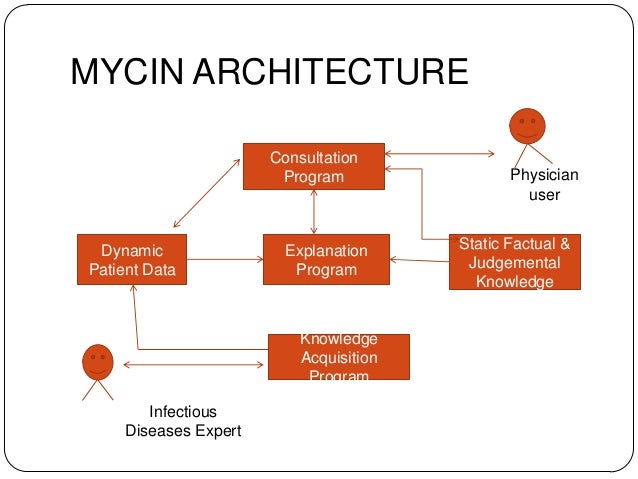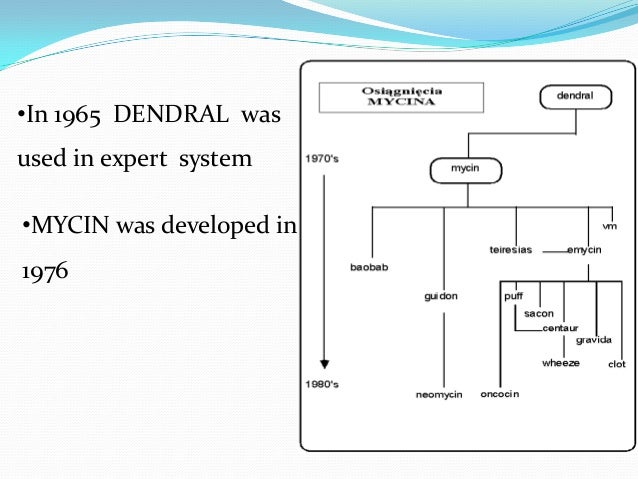Mycin Expert System
Expert Systems Case Studies: MYCIN. Introduction Problem domain: • Selection of antibiotics for patients with serious infections. • Medical decision making. Mycin is an expert system that can be programmed with knowledge database for different domains (e.g. Medical diagnosis). It asks questions, reasons, gives explanations on why it asked the question, and deals with uncertainties. See the example below. MYCIN: MYCIN is the name of a decision support system developed by Stanford University in the early- to mid-seventies, built to assist physicians in the. Let us illustrate the action of an expert system by considering the behaviour of an actual one MYCIN a medical expert system. MYCIN but there are expert systems. Lectra System Modaris V6 Software Update there.


Has related information at Mycin was an early expert system developed over five or six years in the early 1970s at Stanford University; it was written in Lisp, by Edward Shortliffe under the direction of Bruce Buchanan and others; it derived from the earlier Dendra] expert system, but considerably modified and extended the basic Dendral software. This computer system was designed to diagnose infectious blood diseases and recommend antibiotics, with the dosage adjusted for patient's body weight — the name derived from the antibiotics themselves, as many antibiotics have the suffix '-mycin'.
Contents • • • • • Method [ ] Mycin operated using a fairly simple inference engine,a knowledge base of ~500 rules. It would query the physician running the program via a long series of simple yes/no or textual questions. Rf Moonlight New Client Torrent more. At the end, it provided a list of possible culprit bacteria ranked from high to low based on the probability of each diagnosis, its confidence in each diagnosis' probability, the reasoning behind each diagnosis (that is, Mycin would also list the questions and rules which led it to rank a diagnosis a particular way), and its recommended course of drug treatment. Despite Mycin's success, it is sometimes now used as a cautionary tale in AI courses for people who generate their own ad hoc probability frameworks. Mycin had a limited depth to its reasoning hierarchy due to the noise introduced by its certainty factor system. This problem can be solved by using a rigorous probabilistic framework, such as Bayesian statistics. Results [ ] Research conducted at the Stanford Medical School found Mycin to have a correct diagnosis rate of about 65%, which was better than most physicians who were not specialists in diagnosing bacterial infections, even though it was worse than those physicians who were themselves experts in the field who had average correct diagnosis rates of about 80%.
Practical use [ ] Mycin was never actually used in practice. This wasn't because of any weakness in its performance — in tests it outperformed members of the Stanford medical school. It was as much because of ethical and legal issues related to the use of computers in medicine — if it gives the wrong diagnosis, who can be held responsible? Issues with whether human experts would find it acceptable to use arose as well. A difficulty that rose to prominence during the development of Mycin and subsequent complex expert systems has been the extraction of the necessary knowledge for the inference engine to use from the humans expert in the relevant fields into the rule base (the so-called knowledge engineering). References [ ] • The AI Business: The commercial uses of artificial intelligence, ed.
Patrick Winston and Karen A. External links [ ] • -(edited by Bruce G. Buchanan and Edward H. Shortliffe; ebook version) •, system based on MYCIN •: A Ruby Implementation' • • -(by John McCarthy) •.